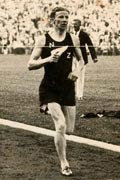 It says something of the flawed sports psyche of
It says something of the flawed sports psyche of The question relates to Lovelock's death in 1949 at the
Lovelock, the 1936 Olympic Games 1500m champion and world record holder over the mile and 1500m during his athletics career, had moved to the
But despite all his achievements on the athletics track, and in his medical career, this question of suicide had been, unfairly, an asterisk on his record in the minds of some.
Rather than accept the fact it had been ruled by the local coroner to be death by accident a sporting consipacy theory went into action, and among many other aspects of his career, the theory was fuelled by the novelised version of his life penned by
Recently, New Zealand medical man, and former old boy of Lovelock's Timaru Boys' High School, Dr Graeme Woodfield has undertaken considerable research on Lovelock's medical career and has also worked with several specialists in their fields to produce a book, Jack Lovelock - Athlete and Doctor (Trio Books).
After a brief run through (pardon the pun), Lovelock's athletic career, Woodfield gets into the medical side, investigating the vaccine with which Lovelock injected himself during his career, and then several incidents after his retirement from the track that affected the health of Lovelock.
The vaccine which has excited the conspiracists that Lovelock may have taken performance enhancing drugs turned out to be of placebo effect only for an arthritic complaint that Lovelock developed after having a cartilage removed.
But it was two riding accidents, one of which resulted in Lovelock being found unconscious up to two hours after he fell from his horse, and remaining unconscious for two days in hospital. He broke his collarbone, and after he was released from his hospital it was found that he had broken one of two bones that serve as the floor of the eye socket and is a very painful injury. This left him suffering double vision and later pictures of Lovelock show him wearing glasses with one cloudy lens covering the affected eye.
Another fall, although backed by only one account, was said to have occurred when he hit his head falling off an army truck and suffering a concussion. The cumulative effect of the injuries proved life changing for Lovelock who suffered periods of dizziness and also lost the balance which had been a hallmark of his athletic career.
Harold Coop, an
He said such patients needed to be careful in their orientation of space and judgment and body position because confused information could cause occasional attacks of severe vertigo.
Coop concluded his comments by saying: "They need to be very careful with uneven ground, moving situations like revolving and subway doors, machinery, stairs and escalators, and, above all, with moving traffic. If they move their body or their head wrongly, a car that looked distant might suddenly be a threat.
"On the day Jack Lovelock died he went to work in the usual way, even though he had the flu. However, his colleagues thought his toxic appearance was bad enough to tell him to go home to bed. He had apparently self-medicated with a new antihistamine drug.
"When he went home, via the subway, he fell under a train. His glasses, quite possibly of little help for a number of reasons, were found in his pocket. It is likely that Lovelock had coped with the steps, crowds and movement of this expedition many times before, by a variety of optical and body tricks now familiar to him, even though a sudden wrong movement in a crowd situation could always be a threat to him.
"But add to that the ever-present imbalance, an illness, and the possible effects of a drug, and it is not hard to imagine that at one vital moment he got it wrong, or felt suddenly dizzy near the edge of the platform."
This consideration alone deals a significant blow to the suicide theorists, and there are more included in the book.
Lovelock was a magnificent athlete, unafraid to use his body to attempt to gain an advantage over his rivals and his mind to increase his chances of success. That is how he best deserves to be remembered in